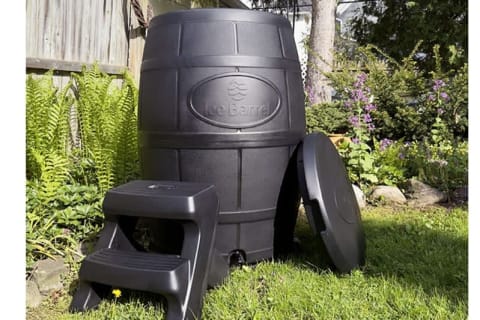Advertisement
How To Cold Plunge + Best Cold Plunge Temperature, Per Experts



Just the words "cold plunge" may sound intimidating. However, this popular form of cold water immersion comes with a bevy of expert- and research-backed health benefits, including improved mood1 and increased insulin sensitivity2.
If you're curious about the world of cold plunging or have already given it a try and want to learn more, you're in luck: Read on for everything you need to know, including how to cold plunge and the best cold plunge temperature.
What is a cold plunge?
Josh Weight, sports and exercise physical therapist and Director of Gravity Physio, Brookvale, explains that a cold plunge is a therapeutic practice that involves submerging your body into a cold tub (or container) of water for a fixed period of time.
Benefits of cold plunges
Cold immersion, such as in the form of cold plunges, can come with a myriad of benefits. Although more research on the topic as a whole has to be done, below are some benefits of cold plunge tubs:
Muscle recovery: Kimberly Collier, M.S., A.T., ATC, supervisor of Athletic Training at Henry Ford Health shares that individuals, such as athletes, popularly use cold water immersion as a recovery tool following intense workouts3. "It's thought to reduce muscle soreness, swelling and aid in a quicker recovery," she says.
Reduce joint pain: If you suffer from joint pain, such as that caused by arthritis, cold plunging may offer you some relief. Weight shares that cold exposure enhances circulation and may reduce inflammation.
This reduction of inflammation, Weight points out, is not just helpful in aiding muscle recovery but can also help lessen joint pain and improve mobility.
Increased insulin sensitivity: Cold plunging may benefit you if you struggle with blood sugar issues. According to recent studies, repeated cold water immersion may reduce insulin resistance and improve insulin sensitivity2. However, further research needs to be done.
Increased alertness and improved mood: Beyond physical benefits, cold water immersion can also boost your mood1. "The cold water stimulates the release of endorphins and activates the sympathetic nervous system," says Weight, "which can lead to increased alertness and improved mood."
Best cold plunge temperature
Collier recommends cold plunge temperatures between 50 and 60 degrees; anything lower could cause harm, but anything higher may not give you your desired results.
"Any lower [than 50 degrees] may cause adverse reactions," Collier confirms. "While any higher [than 60 degrees Fahrenheit] and you won't get the therapeutic result."
Weight, who explicitly says you should stay within 50 to 59 degrees Fahrenheit when it comes to cold plunge temperature, says, "This range is cold enough to elicit the desired physiological responses without posing significant health risks."
How to bring cold plunging into your routine
If you are curious about how to cold plunge but can't swing daily trips to a wellness studio, don't worry—cold plunging can be done at home.
"Use your bathtub," advises Collier. "Or a large trash can that can comfortably fit your body." She explains that you can fill either up with cold water and then add ice right from your freezer.
"As you're planning your hard workout days, you can also plan your immersion days," she continues.
"It takes time to fill up a tub, so have someone do it for you [while you're working out] or fill it up halfway before you leave," Collier says. This way, you can add the rest of the water or ice when you return and jump in immediately.
If you're interested in cold plunging and are looking to take the next step, Weight points out that inflatable cold plunge tubs are also available. "There are numerous inflatable ice baths on the market now that offer an affordable entry point to the full body, cold plunging scene," he shares.
For those seeking more advanced options, be sure to check out some of our top cold plunge tubs, including the Ice Barrel and the Plunge.
At-home cold plunge tubs
How long should you cold plunge?
The amount of time a cold plunge should last depends on the individual, but Collier says each session should typically be around three to five minutes, while Weight suggests something between two and eight minutes.
"Skin will be numb three to five minutes into the immersion," Collier explains. "Treatment shouldn't last more than 15 minutes at the appropriate temperature."
How can you help your body adjust to the cold temperature?
Weight recommends starting gradually and paying close attention to your body's response. "Begin with shorter durations, like one to two minutes, and gradually increase the time as your body becomes accustomed to the cold," he explains.
One way to help your body get used to cold water plunging is by incorporating cold showers into your routine.
"A helpful technique to acclimate is the cold shower method, where you gradually lower the water temperature during your regular shower," Weight says. "This helps your body adjust to the cold over time."
Another trick, which Collier suggests, is starting off by only using tap water with no ice.
What to do after a cold plunge?
Try to hold back the urge to jump right into a hot shower after cold plunging. Doing so could cause more harm than good.
"After a cold plunge, it's advisable to warm up gradually," warns Weight. He says you can easily do this by putting on warm, dry clothes or sipping a warm drink.
"Raising your temperature back up too quickly can shock your circulatory system and lead to syncope, which is fainting, due to sudden loss of blood pressure, so it is not advised," Weight adds.
How often should you cold plunge?
Collier explains that there's no one-size-fits-all regimen for cold water immersion, and when used with other forms of regular active recovery, such as stretching, light workout days, healthy eating, and good hydration habits, one to two times per week should be sufficient.
"Cold water immersion should be seen as a recovery tool, not the end-all-be-all," Collier adds.
Weight reiterates that the frequency of cold plunging may vary according to one's tolerance and goals.
"Some people find benefit in doing it daily, say for arthritic joint pain," he explains. "Others might prefer every few days, and some will solely use it post-exercise as a muscle recovery method."
Ultimately, Weight stresses that it's important to "listen to your body" and not overdo it.
Potential risks and side effects of cold plunging
Although cold plunging comes with many benefits, it isn't without potential risks and side effects.
For instance, Weight shares that cold plunging may cause hypothermia if not done correctly. "Especially if the water is extremely cold or if you stay in for too long," he adds.
He also shares that individuals with heart conditions, circulatory problems, and other medical issues should always check in with their doctor before cold plunging. "It's also important to avoid cold plunging if you're pregnant," he advises.
Additionally, Collier explains that those living with Raynaud's disease should skip cold immersions as it could result in tissue death. She points out that some individuals may be allergic to the cold and have adverse reactions, such as hives or joint pain, while others may panic from the cold, which could result in increased heart rate and blood pressure.
"Overall, while cold plunging can have various benefits, it's essential to approach it with caution and moderation, paying attention to your body's responses and limits," Weight advises.
FAQ:
What is too cold for a cold plunge?
Experts recommend that any temperature below 50 degrees Fahrenheit may be too cold for a cold plunge.
Are there any negatives to cold plunging?
Potential risks associated with cold plunging may vary from person to person. Be sure to check in with your doctor before doing cold plunges.
How often should you cold plunge?
This will vary based on the individual's needs, but Collier explains that once or twice a week should be sufficient.
The takeaway
Incorporating cold plunges into your routine can have positive health effects. Experts say it can help aid muscle recovery and may reduce inflammation—and studies have found cold plunging can even help improve mood. If you're interested in taking the next step, check out our recommendations for the best cold plunge tubs.
3 Sources
- https://www.ncbi.nlm.nih.gov/pmc/articles/PMC9953392/#:~:text=We%20measured%20brain%20connectivity%20and,having%20a%20cold%2Dwater%20bath.
- https://www.ncbi.nlm.nih.gov/pmc/articles/PMC9518606/#:~:text=Such%20findings%20have%20been%20observed,concentrations%20%5B73%E2%80%9375%5D.
- https://pubmed.ncbi.nlm.nih.gov/35157264/

